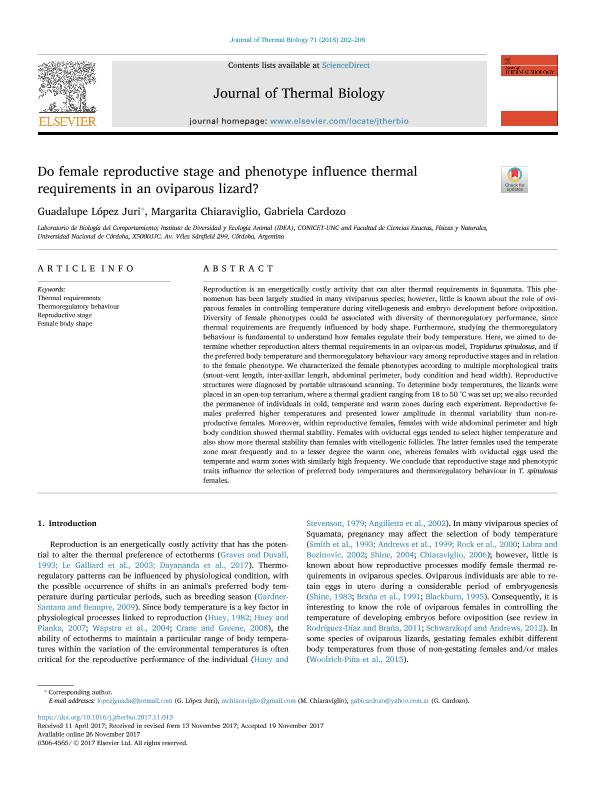Mostrar el registro sencillo del ítem
dc.contributor.author
López Juri, Guadalupe

dc.contributor.author
Chiaraviglio, Margarita

dc.contributor.author
Cardozo Milanesio, Gabriela Alejandra

dc.date.available
2018-11-12T19:16:21Z
dc.date.issued
2018-01
dc.identifier.citation
López Juri, Guadalupe; Chiaraviglio, Margarita; Cardozo Milanesio, Gabriela Alejandra; Do female reproductive stage and phenotype influence thermal requirements in an oviparous lizard?; Pergamon-Elsevier Science Ltd; Journal of Thermal Biology; 71; 1-2018; 202-208
dc.identifier.issn
0306-4565
dc.identifier.uri
http://hdl.handle.net/11336/64274
dc.description.abstract
Reproduction is an energetically costly activity that can alter thermal requirements in Squamata. This phenomenon has been largely studied in many viviparous species; however, little is known about the role of oviparous females in controlling temperature during vitellogenesis and embryo development before oviposition. Diversity of female phenotypes could be associated with diversity of thermoregulatory performance, since thermal requirements are frequently influenced by body shape. Furthermore, studying the thermoregulatory behaviour is fundamental to understand how females regulate their body temperature. Here, we aimed to determine whether reproduction alters thermal requirements in an oviparous model, Tropidurus spinulosus, and if the preferred body temperature and thermoregulatory behaviour vary among reproductive stages and in relation to the female phenotype. We characterized the female phenotypes according to multiple morphological traits (snout-vent length, inter-axillar length, abdominal perimeter, body condition and head width). Reproductive structures were diagnosed by portable ultrasound scanning. To determine body temperatures, the lizards were placed in an open-top terrarium, where a thermal gradient ranging from 18 to 50 °C was set up; we also recorded the permanence of individuals in cold, temperate and warm zones during each experiment. Reproductive females preferred higher temperatures and presented lower amplitude in thermal variability than non-reproductive females. Moreover, within reproductive females, females with wide abdominal perimeter and high body condition showed thermal stability. Females with oviductal eggs tended to select higher temperature and also show more thermal stability than females with vitellogenic follicles. The latter females used the temperate zone most frequently and to a lesser degree the warm one, whereas females with oviductal eggs used the temperate and warm zones with similarly high frequency. We conclude that reproductive stage and phenotypic traits influence the selection of preferred body temperatures and thermoregulatory behaviour in T. spinulosus females.
dc.format
application/pdf
dc.language.iso
eng
dc.publisher
Pergamon-Elsevier Science Ltd

dc.rights
info:eu-repo/semantics/openAccess
dc.rights.uri
https://creativecommons.org/licenses/by-nc-nd/2.5/ar/
dc.subject
Female Body Shape
dc.subject
Reproductive Stage
dc.subject
Thermal Requirements
dc.subject
Thermoregulatory Behaviour
dc.subject.classification
Ecología

dc.subject.classification
Ciencias Biológicas

dc.subject.classification
CIENCIAS NATURALES Y EXACTAS

dc.title
Do female reproductive stage and phenotype influence thermal requirements in an oviparous lizard?
dc.type
info:eu-repo/semantics/article
dc.type
info:ar-repo/semantics/artículo
dc.type
info:eu-repo/semantics/publishedVersion
dc.date.updated
2018-10-22T16:48:35Z
dc.journal.volume
71
dc.journal.pagination
202-208
dc.journal.pais
Estados Unidos

dc.description.fil
Fil: López Juri, Guadalupe. Consejo Nacional de Investigaciones Científicas y Técnicas. Centro Científico Tecnológico Conicet - Córdoba. Instituto de Diversidad y Ecología Animal. Universidad Nacional de Córdoba. Facultad de Ciencias Exactas Físicas y Naturales. Instituto de Diversidad y Ecología Animal; Argentina
dc.description.fil
Fil: Chiaraviglio, Margarita. Consejo Nacional de Investigaciones Científicas y Técnicas. Centro Científico Tecnológico Conicet - Córdoba. Instituto de Diversidad y Ecología Animal. Universidad Nacional de Córdoba. Facultad de Ciencias Exactas Físicas y Naturales. Instituto de Diversidad y Ecología Animal; Argentina
dc.description.fil
Fil: Cardozo Milanesio, Gabriela Alejandra. Consejo Nacional de Investigaciones Científicas y Técnicas. Centro Científico Tecnológico Conicet - Córdoba. Instituto de Diversidad y Ecología Animal. Universidad Nacional de Córdoba. Facultad de Ciencias Exactas Físicas y Naturales. Instituto de Diversidad y Ecología Animal; Argentina
dc.journal.title
Journal of Thermal Biology

dc.relation.alternativeid
info:eu-repo/semantics/altIdentifier/doi/http://dx.doi.org/10.1016/j.jtherbio.2017.11.013
dc.relation.alternativeid
info:eu-repo/semantics/altIdentifier/url/https://www.sciencedirect.com/science/article/pii/S0306456517301377
Archivos asociados
